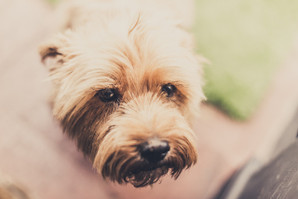Product Highlight: Dog Beard and Tear Stain Remover Pack
Anyone who has ever owned a toy dog knows the constant battle that must be waged against dog beard and tear stains. The problem is that many owners don’t know the underlying causes of them – they are many and varied. But even after you discover the root cause of it, it is an unending battle that must be waged on a daily basis in order to get rid of them and keep it that way.

Root Causes of Beard and Tear Stains
At the microscopic level, your dog’s tear stains are caused by bacteria. That’s one of the reasons why, while all dogs can suffer from beard and tear stains, it’s mostly light colored toy dogs that suffer from epiphora – the syndrome characterized by excessive tearing.
For the most part, epiphora is mostly noticeable in white and light colored dogs that tend to suffer from excessive tear production. Over time, those tear streaks leave rusted brown stains on the fur around the eyes. It’s as irritating as it is for humans when our tear ducts over-produce, but it’s not really health threatening. It is however a clear sign that your dog is suffering from epiphora.
Another, more dangerous but common root cause of tear stains is porphyrins. Basically, porphyrins are bacteria contained in your dog’s waste. They don’t only go number two to empty their bowels. When they tear, slobber, and pee, they are excreting little molecules that contain waste from their bowels. The iron contained in those molecules cause the brown staining that darkens over time.
Top 4 Causes of Beard and Tear Stains
Tears and waste excretion are the cause. What creates the staining is a combination of improper hygiene and typical dog behavior. It seems impossible at times to fix it, but beard and tear stains can be removed and kept at bay. Here are the top 4 common causes of bead and tear stain.
#1: Dog Spit
Think of how many times and how many ways your dog spit gets on things. It’s on their fur, on your furniture, even on you. That dog spit contains waste byproducts that cause tear staining around the mouth of dogs with beards. When they eat and drool, over time, that build up creates dark brown staining.
#2: Bad Diet
Your dog’s diet could also be one of the things you can change that could be causing the staining. If you are feeding your dog artificially colored dog treats, that's likely one reason why your dog may be getting beard stains around its mouth.
#3: Dirty Dog (Owners)
It’s really not fair to blame the dog for beard and eye stains that are the result of poor hygiene. Let’s put the blame where it belongs, on the owner. If you notice that your dog has clumps of tears in its eyes but you don’t do anything about it, or if you don’t bathe them frequently enough or brush the fur around their mouths, there will be staining.
#4: Sick Dog
If the other three problems aren’t the culprit and improving grooming habits haven’t helped, it could be that your dog is sick. There are medical conditions in your dog for which excessive tearing is a symptom. One way to tell if it is a medical condition is if the problem occurs suddenly and is accompanied with other symptoms of illness.
Your dog could also be suffering from allergies which is the main medical condition afflicting dogs with tear and beard stain problems. There are other causes that there really isn’t anything that you can do about – it’s just how they were made – like:
Hair Growth
Ingrown Eyelashes
Large Eyes
Large Tear Glands
Narrow or Small Noses
Shallow Eye Sockets
Small Tear Duct Openings
Teething
Many of these problems just come with the breed or are just growing pains. Teething will eventually stop. Hair growth will irritate for a while and then go back to normal. But if you insist on buying a Pug or Poodle, with large eyes and short snouts, prepare for battle with a reliable dog beard and tear stain remover and regimen.
Dog Breeds Prone to Tear Stains
When you were shopping for a dog, if you took into account the breed, then you know why your dog is going to wrestle with tear and beard staining. Again, any dog can get an eye infection which results in staining, but it shows more on light colored dogs. Pig nosed, toy sized, big eyed dogs are generally the types of dogs that suffer the worst, which include:
Bichon Frises
Bulldogs
Chihuahuas
Cocker Spaniels
Lhasa Apsos
Malteses
Pekineses
Pugs
Shih-Tzus
And Poodles
Dog breeders have created whole new breeds that combine toy dogs with bigger dogs. For example Labradoodles combine Labrador Retrievers with Poodles and Puggles are Pugs mixed with Beagles.
Some of these new hybrid breeds, including Puggles, are presenting the same problem with beard and tear stains as their pure bred cousins. In addition to Puggles, Maltese Poodle mixes called Maltipoos, Cavalier King Terriers bred with Shih Tzus known as Cavashus, and Goldendoodles, Golden Retrievers mixed with Poodles, all suffer from tear staining.
When to See the Vet about Tear Stains
If you own any of these breeds, you should work hard to remove beard and tear stains, not just because they’re unsightly, but because they could be the result of a serious underlying health issue. The way the tear stains look will help you deduce when you should take your dog to see the vet.
Dark reddish brown tear stains accompanied with an odor probably means that your dog has a yeast infection. If the tear staining starts suddenly and is accompanied by drainage, there is a chance that your dog may have a clogged eye duct, eye infection, or could be suffering from an eye disease like glaucoma. In these cases, you should take your dog to the vet as soon as possible to prevent the issue from becoming worse.

Beard and Tear Stain Removal is a Never-ending Battle
After you’ve gotten to the root of your dog’s staining problem, it is time to develop a plan for combating it. The first thing you have to prepare for is the fact that there is no end to this battle. For as long as you have your particular breed of dog, you will have to adopt a daily regimen that helps to prevent staining.
But, before we can get to a daily regimen, we have to get rid of the existing stains so that you can start fresh. Keep in mind that there will be a number of factors that will determine how best to treat your dog’s tear stains.
For example, the type of breed will determine the type of fur your animal has which tells you how strong the remedy must be. Super white dogs will show the tiniest of stains. The frequency of your daily maintenance routine, for example, will have to account for that whereas the owner of a brown furred Chihuahua could probably skip a day or two.
Another factor to consider is how those stains have been treated in the past. Certain antibiotics may make your dog’s fur resistant to some treatments. Bleaches and whiteners could also make the time it takes for your daily efforts to bear fruit longer and the process more intense. Check out these 10 remedies for removing existing dog beard and tear stains.
Steps for Beginning a Daily Stain Removal Regimen
Removing stains from your dog’s fur is not a onetime thing. To make it as manageable as possible, a daily routine will help keep your dog’s fur from amassing stains. Even if you are busy and on the go, you can take steps to keep your dog’s eyes moisture free and its hygiene up to par.
How clean is your dog dish? Are they drinking fresh water everyday instead of tap water that can contain impurities that are excreted through the tear ducts creating those rusty brown stains? Take steps to make sure that your pet’s food and water dishes are clean.
Are Natural Stain Removers Effective?
Eye Envy's Dog Beard and Tear Stain Remover is an all natural system that helps you to maintain fur health over the long term. The Dog Beard and Tear Stain Remover Pack is a two step system that works to remove existing stains and then to treat the areas that are prone to staining daily.
When you use our Off the Beard and Tear Stain Solution with our dry powders, it’s easy to keep dirt away from your dog’s wet eyes and slobbery mouth. Using our application pads, you can get to the specific parts of your dog’s face that suffer from staining.
Most importantly, these products are allergy-free and treat the underlying bacterial issues that create staining without irritating your dog’s skin. The pack gives you all of these effective and natural products for an all-in-one solution to combat your dog’s fur stains.
